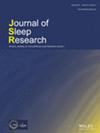Psychophysical changes after total sleep deprivation and experimental muscle pain
IF 3.4
3区 医学
Q2 CLINICAL NEUROLOGY
引用次数: 0
Abstract
SummarySleep disturbances exacerbate chronic pain, increase psychological load, and increase inflammation. Delayed onset muscle soreness (DOMS) mimics aspects of chronic pain, predominantly affecting peripheral pain mechanisms, while experimental sleep provocations have been shown to impact central pain mechanisms. This study aimed to combine a DOMS model with total sleep deprivation (TSD) to create a novel model affecting both peripheral and central pain mechanisms. A total of 30 healthy participants attended two sessions (baseline and follow‐up) separated by 24 h of TSD and a home rating after 48 h. Assessments of interleukin 6 (IL‐6) levels, sleep quality, pain catastrophising, affect, and symptoms of depression and anxiety were included in the baseline and follow‐up sessions. Additionally, pressure pain and tolerance thresholds, temporal summation, and conditioned pain modulation (CPM) were assessed using cuff‐pressure algometry in the baseline and follow‐up sessions. DOMS was induced with eccentric calf raises during the baseline session followed by 24 h of TSD. At follow‐up pain tolerance (完全剥夺睡眠和实验性肌肉疼痛后的心理物理变化
摘要睡眠障碍会加剧慢性疼痛、增加心理负担和炎症反应。延迟性肌肉酸痛(DOMS)可模仿慢性疼痛的某些方面,主要影响外周疼痛机制,而实验性睡眠刺激已被证明会影响中枢疼痛机制。本研究旨在将 DOMS 模型与完全剥夺睡眠(TSD)结合起来,创建一种同时影响外周和中枢疼痛机制的新型模型。共有 30 名健康参与者参加了两次治疗(基线和随访),每次治疗间隔为 24 小时的 TSD 和 48 小时后的家庭评分。基线和随访包括对白细胞介素 6(IL-6)水平、睡眠质量、疼痛灾难化、情感以及抑郁和焦虑症状的评估。此外,在基线和后续疗程中,还使用袖带压力测定法评估了压力疼痛和耐受阈值、时间总和和条件疼痛调制(CPM)。在基线疗程中使用偏心小腿抬高法诱导 DOMS,然后进行 24 小时的 TSD。与基线相比,随访时疼痛耐受性(p = 0.012)明显降低,CPM(p = 0.036)明显受损。心理变化包括疼痛灾难化(p = 0.027)、积极情绪(p < 0.001)、消极情绪(p = 0.003)和焦虑(p = 0.012)的下降。基于基线体重指数、疼痛阈值、心理测量和 IL-6 的探索性回归模型分别预测了 24 小时和 48 小时后 DOMS 疼痛强度的 58% 和 68%(p < 0.01)。将 DOMS 与 1 晚 TSD 结合使用会诱发痛觉过敏、CPM 受损和心理状态改变。基线炎症、心理测量和疼痛敏感度的组合可显著预测24小时和48小时后的DOMS疼痛强度。
本文章由计算机程序翻译,如有差异,请以英文原文为准。
求助全文
约1分钟内获得全文
求助全文
来源期刊

Journal of Sleep Research
医学-临床神经学
CiteScore
9.00
自引率
6.80%
发文量
234
审稿时长
6-12 weeks
期刊介绍:
The Journal of Sleep Research is dedicated to basic and clinical sleep research. The Journal publishes original research papers and invited reviews in all areas of sleep research (including biological rhythms). The Journal aims to promote the exchange of ideas between basic and clinical sleep researchers coming from a wide range of backgrounds and disciplines. The Journal will achieve this by publishing papers which use multidisciplinary and novel approaches to answer important questions about sleep, as well as its disorders and the treatment thereof.
 求助内容:
求助内容: 应助结果提醒方式:
应助结果提醒方式:


